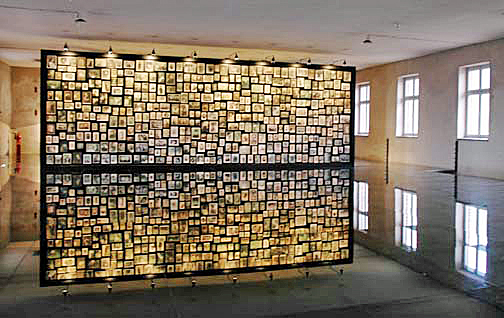
Dead bodies of prisoners who died of typhus at Dachau after the camp was liberated (click on photo to enlarge)
I checked the news this morning in an attempt to find out if the Dachau “Arbeit Macht Frei” gate has been recovered yet. No word on the gate, but I did find a news story which is headlined “Merkel urges action on Dachau gate theft”.
This quote is from the news article, in which Angela Merkel is quoted:
During World War II [Dachau] became a death camp where more than 41,000 Jews were slaughtered before US troops liberated it on April 29, 1945.
The news article does not say how many non-Jews were killed at Dachau, nor how many Jews were killed by some other means besides being slaughtered. If you don’t know the meaning of the word “slaughtered” check this out: http://dictionary.reference.com/browse/slaughtered
Usually, animals are slaughtered to provide food. I doubt that the “slaughtered Jews” were eaten, but what about their skin? Was the skin used to make lampshades? According to the testimony of Dr. Franz Blaha, the skin of the dead Jews was used to make a number of items. I wrote about this on my website at
http://www.scrapbookpages.com/DachauScrapbook/DachauTrials/MartinGottfriedWeiss01.html
How many prisoners actually died at Dachau, according to the official records?
There were 31,951 deaths at the main Dachau camp during the 12 years that the camp was in existence, according to a report made by the International Tracing Service at Arolson, Germany in 1977. The Tracing Service is part of the International Red Cross. This report was based on death records meticulously kept by the Nazis.
The Dachau camp records were confiscated by the American Army, after the camp was surrendered to the American “liberators” on April 29, 1945. These records are currently being kept in the National Archives in Washington, DC.
According to the camp records, there were 3,752 deaths at Dachau in the first seven years that the camp was in operation, but the death toll escalated to 13,158 deaths in the first four months of 1945. Just in the month of February 1945, there were 3,977 deaths at Dachau, more than in all of the seven years before the war. Most of these deaths in 1945 were due to a typhus epidemic in the camp which began in the fall of 1944 when prisoners were evacuated from the camps in Poland and brought to Dachau.
Was Dachau really a “death camp” for the slaughtering of Jews? Let’s examined the records kept at Dachau. The Dachau camp records show that there were 28,838 Jews brought from Auschwitz to the Dachau main camp between June 18, 1944 and March 9, 1945. Before being transferred to the 11 Kaufering sub-camps near Landsberg, the Jews were kept in quarantine at Dachau for two weeks in an effort to prevent the spread of disease.
At the Dachau main camp, these Jewish prisoners were first dipped in a tub of disinfectant, then given a shower and issued clean clothes that had been disinfected with Zyklon-B in a Gaskammer.
The photo below shows a door into a Gaskammer at Dachau where clothing was disinfected with Zyklon-B gas.

American soldier looks at a door into a clothing disinfection chamber at Dachau, April 1945
Holocaust True Believers claim that 28,838 Jews had been brought to Dachau to be gassed in the shower room at Dachau, although the shower room had not yet been converted into a gas chamber by the American liberators.
The official report of the US Seventh Army, published in 1945, mentioned that 14,700 deaths had occurred at Dachau in the first quarter of 1945.
Paul Berben, a prisoner in the camp, wrote a book entitled Dachau, the Official History 1933 – 1945, in which he stated that 2,888 prisoners had died at Dachau in January 1945, 3,977 prisoners had died in February, 3,668 had died in March and 2,625 had died in April, for a total of 13,158 in the first four months of 1945. These deaths had been caused by a typhus epidemic in the camp.
In the month of May 1945, an additional 2,226 Dachau prisoners died after the camp was liberated, in spite of the excellent care given to them by American military doctors. There were 196 more deaths in June before the typhus epidemic was finally stopped by the use of DDT and the vaccination of all the prisoners. The Germans did not use DDT for fear of harming the environment.

Dachau prisoners were sprayed with DDT by the American liberators after the camp was surrendered to them
At the American Military Tribunal held at the Dachau camp in November 1945, the prosecution stated that 161, 939 prisoners had been processed through Dachau between 1940 and 1945 and that over 25,000 of them had died. According to the figures in Paul Berben’s book, the exact number of prisoners who died at Dachau during this period was 27,839.
The US Seventh Army report stated that an estimated 229,000 prisoners had been processed at Dachau since the camp opened on March 22, 1933 including around 7,000 who had arrived in the last three weeks of April, 1945. The camp records showed that 206,206 prisoners had been registered in the camp in the 12 years that Dachau was a concentration camp, but in the chaos of the last days before the camp was surrendered to the Americans, some prisoners had not been registered.



























